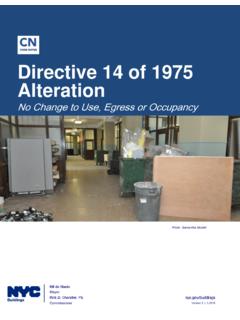Transcription of Welcome to Wetlands 101 - Environmental Concern Inc.
1 1 Wetlands 101 Welcome toBrought to you by: Environmental Concern3 Introduction Throughout the slides you will come across words that are underlined. By holding your cursor over the underlined word, a definition or answer to a question will appear. Throughout this presentation there are self quizzes. The question to the quiz will appear of the first slide while the answer will be on the following : A DefinitionClean Water Act Section 404:Federal Register: Those areas that are inundated or saturated by surface orgroundwater at a frequency and durationsufficient to support, and that undernormal circumstances do support, aprevalence of vegetation typically adaptedfor life in saturated soil Defined AgainSimply stated, in order for an area to beconsidered a wetland , it must possessthree things. Water* wetland Plants wetland SoilsNOTE: Some Wetlands may be dry for up to 97% of the Water Sources Precipitation Surface Flow Groundwater Discharge Ocean River LakeWetland Water Losses Evaporation/Transpiration Outflows Groundwater RechargeHydrology is concerned with the transport of water through the air, over the ground surface and through the strata of the earth.
2 It is the science that treats the various phases of the hydrological CyclePrecipitationRunoffRunoffDischargeW etland Water Sources9 Hydrologic CycleEvaporationEvaporationTranspiration RechargePercolationWetland Water LossesInfiltrationRechargePercolationTra nspiration10 wetland HydroperiodThe hydroperiod of any specific wetland definesthe seasonal pattern of water levels. Often the hydroperiod is considered the signature of awetland. Sometimes the term wetlandhydroperiod is replaced with hydrologicregime .11 Nontidal wetland Hydroperiods Permanent: Flooded throughout the year in all years. Intermittent: Flooded throughout the year except in periods of extreme drought. Seasonally: Flooded in the growing season of most years. Saturated: Substrate is saturated for extended periods in the growing season; standing water is rarely present. Temporary: Flooded for brief periods in the growing season; water table is otherwise well below the wetland HydroperiodsPermanently floodedThis is a lake in a normal growing wetland HydroperiodThis graphic is the same lake that was shown in the previous slide, except that this is the lake during a drought year.
3 During a storm event, the tan and brown areas will mimic the hydrologic regime of intermittently flooded and semipermanently flooded floodedIntermittently floodedPermanently flooded14 Nontidal wetland Hydroperiod Saturated: Substrate is saturated for extended periods in the growing season; standing water is rarely present. The arrow below points to a Wet meadow. A wet meadow is a grassland with waterlogged soil near the surface but without standing water for most of the year. Wet meadow15 Nontidal wetland Hydroperiods Seasonally flooded: Flooded for extended periods during the growing season; usually no surface water by the end of the growing season. The example below is a floodplain wetland . Note the water stained vegetation that indicates the presence of water during the growing wetland Hydroperiods Subtidal: Permanently flooded with tidal water. Irregularly Exposed: Surface is exposed by the tides less often than daily.
4 Regulary Flooded: Flooded and exposed at least once per day Irregulary Flooded: Flooded less often than daily17 Tidal wetland Hydroperiods Subtidal: Permanently flooded with tidal water18 Tidal wetland Hydroperiods Irregularly exposed: Surface is exposed by the tides less often than daily. Irregularly exposed tidal Wetlands are BELOW Mean Low Water and become exposed during times of spring tides (full moon) when the low tides are below Mean Low Water. The area represents the area that is exposed as a result of the spring Regularly flooded: Flooded and exposed at least once per day. The area is exposed during low wetland Hydroperiods20 Tidal wetland Hydroperiods Irregularly flooded: Flooded less often than daily. Irregularly flooded tidal Wetlands area ABOVE Mean High Water and become flooded during spring tides (full moon) and storm tides when the high tides are above Mean High Water.
5 Note: daily high tide is marked by the of wetland Hydrology Primary Visible surface water Saturated Surface Soils Saturated within 18 in. Secondary Oxidized rhyzospheres Water stained leaves surface scouring plant adaptations hydric Soils22 Hydric Soils: wetland Soils are Called Hydric SoilsHow Are Hydric Soils Formed?Soil+ Anaerobic + Anaerobic -> Reducing -> Hydric SoilsConditions Bacteria EnvironmentAnaerobic Conditions all air in pore spaces eventually dissolves out of the soil and into the water leaving the soil without any Bacteria bacteria that need low or no oxygen for metabolic processesReducing Environment when no oxygen is present for chemical and biological processes certain elements (ie iron, magnesium) will release and oxygen and gain a hydrogen of Hydric SoilsSoil Color Hydric mineral soils are USUALLY perceived as grayishin Permeability Organic Hydric Soils high permeability underlain by an impermeable or poorly permeable layer Mineral Hydric Soils poor permeability and will hold water at the surfaceSoil Texture Hydric mineral soils often consist of fine particles, silts and clays that when saturated are generally low Smell Hydric soils may smell sulfurous (rotten egg)24 wetland Soil horizons The picture shows examples of wetland horizons (soil layers).
6 25 Soil Permeability The following graphic is an example of soil permeability. Examples: Large Particles: Gravel Irregularly Shaped Particles: Organic Soil Small Particles: Sand26 Hydrophytic PlantsWhat conditions do hydrophytic plants need toadapt to in order to survive in a saturated orinundated environment? Anoxia: Long periods of little or no oxygen Erosive Conditions: Exposure to moving (often rapidly) water Salinity: Variety of salinity levels toxic to most plants 27 wetland Plant AdaptationsArenchyma:The air spaces found in the stems and roots of herbaceous wetland plants. Lends stability Allows oxygen to diffuse from the leaves (exposed to the atmosphere) to the roots that are often surrounded by saturated Plant Adaptations Oxidized Rhizospheres form when hypoxia is moderate due to infrequent flooding or other factors. Often oxygen diffusion from a wetland plant through the roots is large enough to pas throughthe roots and into the surrounding soil.
7 The passage of oxygen into the surrounding soil causes an oxygenated zone near the root causing an oxidized region (sphere) around the root. 29 wetland Plant Adaptations Roots:roots that develop above the hypoxic zone and assists with the transfer of oxygen to the roots. Prop Roots Pneumatophores Knees30 Prop Roots Prop roots are roots produced above the anoxic zone that are able to function normally in anaerobic environments. They are covered in numerous small pores called lenticles. The prop roots terminate below the waterline in long spongy air-filled submerged roots Lenticels are small pores found on the above-ground roots of some wetland plants. They aide in oxygen transport to roots located below the water line. Red Mangrove31 Pneumatophores Pneumatophores are Spongy root projections usually 20 30 cm (8 12 in.) high and 1 cm ( in.) in diameter that assist in oxygen transfer to the roots during low tides.
8 There are often thousands of pneumatophores associated with one Knees are similar to pneumatophores in that they originate from the plant roots. However they are much larger and much less numerous. It is thought that they improve gas exchange, however this is currently only a theory. Cypress Swamp33 wetland Plant Adaptations Seed Production Delaying or accelerating seed production Floating seeds Vivipary ability for seed to germinate while attached to treeB. Structural Adaptations Butresses swelling or thickening of a tree trunk adding stability Rigid Stems C. Salt Exclusion34 Self-Quiz 1 Using the knowledge gained from previous slides, answer the following questions. Answers can be foundon the next What three things are necessary for an are to be considered a wetland ?2. Butressed trunks, knees and the ability to float are all examples of what?
9 3. Name three indicators of a hydric soil?4. True or False: Wetlands must be wet a majority of the The presence of water stained leaves in a seemingly dry land suggest what?35 Self - Quiz 1 - Answers1. Water, wetland Soils, wetland Plants (slide 6).2. Ways in which plants have adapted to saturated soils with low oxygen levels (slide 32).3. Soil color, Soil permeability, Soil Texture, Smell (slide 22).4. False: Areas must be seasonally inundated and have saturated soils during the growing season (slide 5). 5. Seasonal wetland hydrology (slide 10).36 wetland : Functions and Values The following slides show examples of wetland functions and values. The difference between a wetland function and a wetland value is that functions are properties that a wetland naturally provides. Values are wetland properties that are valuable to : FunctionsPhysical/Hydrological Functions Flood Control Coastal Protection Ground Water Recharge Sediment Traps Atmospheric Equilibrium38 Flood ControlWetlands act as protective natural Sponges by capturing, storing and slowly releasing water over a long period of time, thereby reducing the impact of floods.
10 39 Coastal Protection Coastal marshes, mangrove swamps and other estuarine Wetlands act as effective storm buffers. Studies have concluded that more than half of normal wave energy is dissipated within the first 3meters of encountering marsh vegetation such as cordgrass. The erosive nature of tides is also dampened by wetland plants because their roots hold soil in place and their stalks reduce the destructive energy of waves and shoreline with a large amount of erosionStable wetland , preventing Water Recharge Wetlands role in recharging ground water varies widely, but it is clear that Wetlands often contribute to ground water and can be important in recharging Traps Wetlands improve water quality by acting as sediment sinks or basins. They are especially effective at trapping sediments in slow moving water. wetland vegetation slows water velocity and particles settle Equilibrium Atmospheric levels of carbon and sulfur and excess nitrogen contained in fertilizers are lowered by a Wetlands ability to capture and reduce these elements to harmless or inert - Quiz 2 Using the knowledge gained from previous slides, answer the following questions.





